First Church of Christ Scientist
266 North Terrace, Adelaide
Whitehouse Bros, Brisbane, 1957
Addition 1989 George Stephens, Adelaide
2 manuals, 13 speaking stops, 7 couplers, electro-pneumatic action
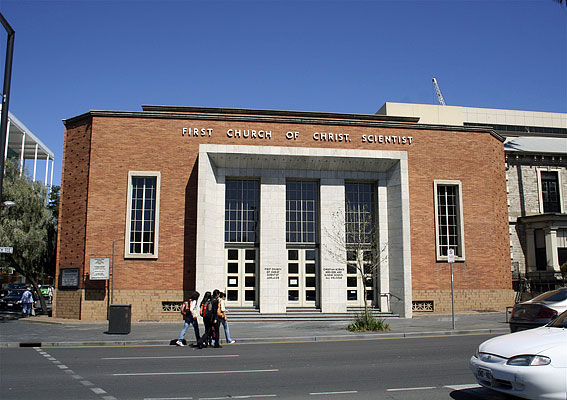
First Church of Christ Scientist, Adelaide
[Photograph by Trevor Bunning (March 2009)]
Historical and Technical Documentation by David Shield
© OHTA 2009, 2017 (last updated September 2017)
The
First Church of Christ Scientist literally stands on Congregational
foundations. Apart from the fact
that the denomination’s founder Mary Baker Eddy was born into a Congregational
family, the current building is sited on what was originally intended to be a
new church for the Independents worshipping in Hindmarsh Square. Building work actually began but
stopped owing to a legal challenge. The unfinished building remained derelict for some years before the First
Church of Christ Scientist, who had been occupying premises in Wakefield
Street, purchased it in 1939. It
was 1953 before they were able to begin building operations on a structure far
less expensive than the original design.1
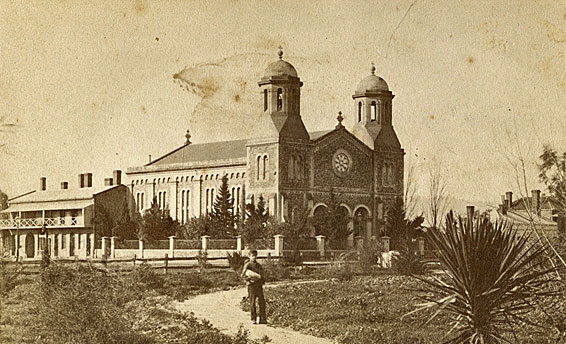
The Congregational Church, Hindmarsh Square (c.1870)
opened in 1862 and sold to the ABC in 1928
[Photograph: State Library of South Australia (B-71558)]
The
story of the building is quite tragic in its own way. It would appear that after the pastorate of J.T. Huston in
1913, the Hindmarsh Square Congregational Church was without settlement for a
time. In that year, a young
Tasmanian, Paul Joseph, had completed his studies at Parkin Theological College
and succeeded the Revd Percy Watson at the Hindmarsh Church where he stayed
till 1915. At some point he
received a call to the Hindmarsh Square Church where he seems to have stayed for
a few months and then rejected the call.2 However, by March 1916, we find he has not only accepted the
call but also paid off a loan on the Hindmarsh Square Building of £1232 from
the Congregational Chapel Building Society of SA (Inc), acquired ownership of
the title deeds, raised a loan from the National Bank, advanced a grandiose
scheme to build a Temple on North Terrace, and is about to build on his own.3

The City Temple proposed by Paul Joseph in 1915
[Photograph: The Mail (Sat 25 March 1916), p. 19.]
Joseph’s
actions resulted from the belief that more people could be attracted to the
Hindmarsh Square church if it were relocated to North Terrace. The media indicated the intention was “to
inaugurate a new mission in Adelaide on quite modern, independent, and popular
lines”, and added, “the experiment will be watched with the greatest interest.” Though no details are known there is
evidence that Joseph approached W.L. Roberts to provide a pipe organ for the
edifice and a contract had actually been let.4
The
architect was Mr C.W. Rutt FAAIA, President of the SA Institute of Architects,
and the contractors Messrs J. King & Son Hindmarsh.
Apparently
Joseph was able to act in the way he did because he had been deluded into
believing he was to receive a legacy from a Tasmanian uncle. The Bank investigated the claim and,
finding it wanting, took legal action.
This
led to the double tragedy. In the
first place, at the tender age of 28, having wife and child, Paul Hamilton
Morris Joseph, resigned as pastor of the church, severed his connection with
the Congregational Union and enlisted in the AIF on 29 August 1916.8 Two years later, on 3 May, he was
posted missing, believed killed.9
On
the other hand, the congregation had no building or minister. The protracted legal case went all the
way to the Privy Council in London, and the result was not favourable for the
church. Although compromise was
reached there were still difficulties. Services ceased and the Hindmarsh Square building was sold to the ABC in
1928. The temple remained
unfinished.
The
building site lay derelict for some 36 years before being purchased by the
First Church of Christ Scientist in 1939. Meeting informally in Adelaide since 1909, the church had grown and
progressively used various halls in the city. The current building was designed by Mr L. Laybourne Smith
and opened for the first service on Sunday 20 January 1957. Coincidentally this was the same day as
the last service for the Scots Church in Flinders street, with its large
Fincham & Hobday instrument, before the congregation transferred to
Chalmers Church, on the corner of Pulteney Street and North Terrace.10

First Church of Christ Scientist, Adelaide,
opened in January 1957
[Photograph by Trevor Bunning (March 2009)]
The
building itself cost £75,000 and was designed to hold 360 with a Sunday School
in the basement capable of holding 300. A marble porch and foyer 70 feet long formed an impressive entrance to
the new church. A reading room had
a separate entrance from “Tavistock” Street, renamed Frome Road.
The Advertiser reporter waxed quite lyrical in describing the features of the new church. Sponge rubber seats, concealed lighting, sound proof walls, air conditioning and a fully equipped nursery were all mentioned. The bright colour scheme including a vivid blue ceiling in the porch and stepped primrose ceiling in the main church with its blue-covered theatre style seats was all noted. There was a public address system. The North Terrace façade was still incomplete, being attractively faced with white marble.11
With declining congregation numbers, the decision was made to move to smaller premises, and the building was placed on the market early in 2017.12
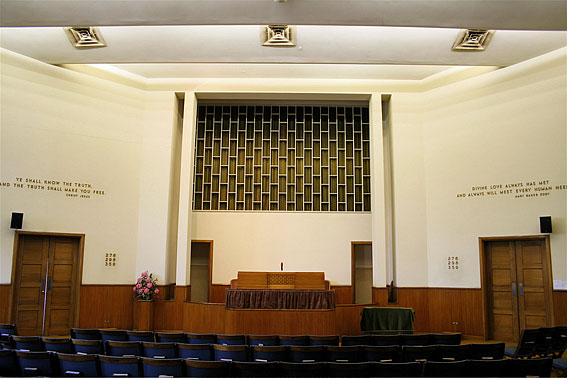
The Whitehouse organ in the First Church of Christ Scientist, Adelaide
[Photograph by Trevor Bunning (March 2009)]
This
organ is the only instrument in South Australia built by the Brisbane organbuilders Whitehouse
Bros. As
described in the Sunday Mail of
19 January 1957, it contained 641 pipes and cost £4,200.13 It was made of Queensland maple and had
imported metal pipes. The organ
was enlarged in 1989 by George Stephens of Adelaide with the addition of a Fifteenth 2ft
to the Great, although there was preparation (at the console only) also for a Mixture II. . The
instrument is centrally located at the front of the building and is covered by
grillwork.
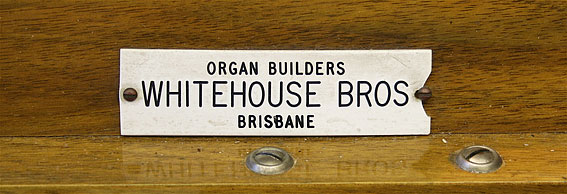
The Whitehouse nameplate on the organ
[Photograph by Trevor Bunning (March 2009)]
The
Whitehouse firm secured contracts to build or rebuild organs for Christian
Scientist churches throughout the country. After rebuilding the large three-manual Dodd organ at First
Church of Christ Scientist, Darlinghurst, NSW in 1937, they built new organs
for the same denomination not only in Brisbane (1940), but also in Chatswood,
NSW (two-manuals, 1941-42), Perth, WA (three-manuals, 1953) and Adelaide, SA
(two-manuals, 1957), as well as overhauling the three-manual Willis at First
Church of Christ Scientist in Melbourne in 1953. All of these instruments used electro-pneumatic action. The strong association with Christian
Science churches may have come through prominent Brisbane organist Miss Margery
Horn, who was a member of the First Church of Christ Scientist, Brisbane, and
played the organ there regularly.14
| GREAT ORGAN Open Diapason Stop Diapason Dulciana Suabe Flute Fifteenth [Mixture] Great Octave Swell to Great Sub Swell to Great Swell to Great Super SWELL ORGAN Violin Diapason Liebl. Gedact Salicional Voix Celeste Principal Oboe Tremulant Swell Super Octave PEDAL ORGAN Bourdon Bass Flute Great to Pedal Swell to Pedal |
8 8 8 4 2 [II] 8 8 8 8 4 8 16 8 |
1989 [1989 - prepared at the console only] TC A A |
Compass: 61/30
3 thumb pistons to Great
3 thumb pistons to Swell
Full organ by thumb piston
Reversible toe piston for
Great to Pedal
Balanced swell pedal
Detached stopkey console.15



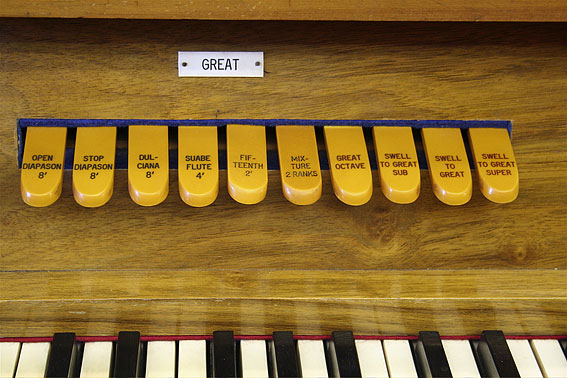
Console details of the 1957 Whitehouse organ,
enlarged in 1989 by George Stephens, Adelaide
[Photographs by Trevor Bunning (March 2009)]
_________________________________________________________________________
1 J. R. Digance, Congregationalism in SA 1837-1962 (Hindmarsh Square Congregational Church), p.185.
2 Advertiser, 15 January 1916, p.19, column 2; ibid,. 9 March 1916, p. 6, column 5.
3 Congregational Year
Book for 1917 (Congregational
Union and Home Mission of SA (Inc)), p.32; Congregational Chapel Building
Society of SA (Inc) Report for the year ended March 31 [1916]; Advertiser, 9 March 1916; ibid., 21 June 1916, p. 5, column 7.
4 W.L. Roberts order book, p 85a, no further details. Roberts also had a newspaper copy of
the building façade in his possession and an undated newspaper article
indicating the contract had been let, 50 yea[rs ago] from Advertiser, 29
March 1916 (presumably dated 29 March 1966).
5 J. Cameron, In Stow’s
Footsteps (1987), p.120.
6 Advertiser, 9 March 1916, p. 6, column 5.
7 Digance, op. cit., p.182.
8 Ibid.; Congregational Union and Home
Mission of SA (Inc) Year Book for 1917,
p.28. The Revd Paul Joseph has
resigned his connection with our ministry and Union; Australian Military
Records Series no B2455, service
no. 3451.
9 Digance, op. cit., p.182.
10 Advertiser, 21 January 1957, p.5.
11 Advertiser, 19 January 1957, p.4 article.
12 Personal communication to David Shield from Ruth Klose (organist), April 2017.
13 Sunday
Mail, 19 January 1957 “From the
Churches” no page.
14 Personal communication to David Shield
from Geoffrey Cox, April 2009.
15 Specification noted by David Shield, March 2009; annotation regarding Mixture II provided by Ian Wardle, September 2017.